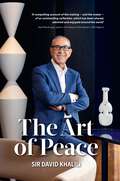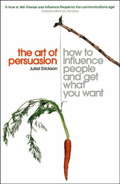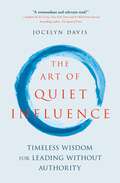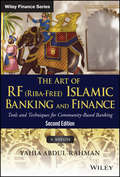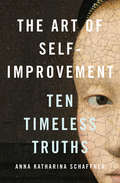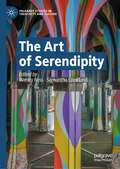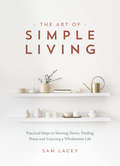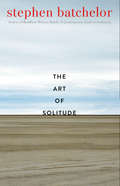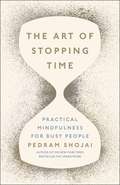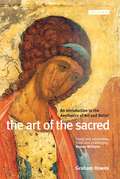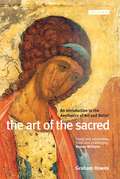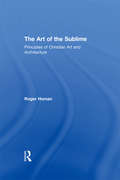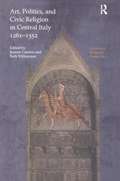- Table View
- List View
The Art of Peace
by Sir David KhaliliIn 1967, Sir David Khalili finished his military service in Iran and travelled to study in the United States with $750 - his remaining royalties from a book he wrote when he was just 14. Over the course of the next five decades he single-handedly, piece by piece, assembled eight of the finest art collections in their field, ultimately becoming one of the world's greatest collectors, about whom Queen Elizabeth II once said: 'It is scary how much this gentleman knows about art.'For the first time, Sir David shares his extraordinary journey: one that has taken him through the souks of North Africa, the auction houses of Europe and the United States, the bazaars of South Asia, and far beyond. Through a riveting collection of real-life adventures, he reveals his collecting strategy, business ethics and what motivates him to continuously collect, conserve, research, publish and exhibit the treasures in his collections. Through his story, Sir David questions how the undeniable power of art can be harnessed to foster greater peace and unity worldwide. No one is better placed to enlighten us.
The Art of Persuasion
by Juliet EricksonYou may think you know what you want in life, but having the idea, the goal, the means, the business plan or the enthusiasm will only get you halfway there. Whatever it is that you want to make happen – whether a new business, community project or innovative idea – the one crucial factor by which it will stand or fall is how well you can communicate it to others. This invaluable book explains just why good communication is so critical and reveals the secrets of honing your skills to ensure your goal is realised. From planning your initiative tois realised. From planning your initiative to making an effective pitch when the stakes are high, international communication coach Juliet Erickson presents the best insights and techniques of persuasive communication that are essential to really make your great ideas happen.
The Art of Public Space: Curating and Re-imagining the Ephemeral City
by Kim GurneyA journey through Johannesburg via three art projects raises intriguing notions about the constitutive relationship between the city, imagination and the public sphere- through walking, gaming and performance art. Amid prevailing economic validations, the trilogy posits art within an urban commons in which imagination is all-important.
The Art of Quiet Influence: Timeless Wisdom for Leading Without Authority
by Jocelyn DavisInfluence is getting things done without coercion. It's strength without force-mindfulness in action. Master influencers walk lightly, talk softly and have no need of a big stick, yet collective success hinges on their words and deeds.Anyone can be a quiet influencer. Featuring twelve specific practices, twelve typical pitfalls and dozens of powerful stories and examples, The Art of Quiet Influence is a roadmap for the journey. Author Jocelyn Davis weaves together the timeless wisdom of Eastern thinkers-from Confucius to the Buddha, from Rumi to Gandhi-with research and insights from modern-day experts, revealing what's wrong with the Western view of influence as short-term persuasion and showing instead how to create trust-based collaborations with lasting impact.
The Art of Reconciliation: Photography and the Conception of Dialectics in Benjamin, Hegel, and Derrida
by D. PeterssonDag Petersson offers a comprehensive critique of the philosophy that has dominated 200 years of modern thought, politics, economy, and culture. The basic question is this: why does dialectical metaphysics fail to keep what it promises? What is it about dialectics, that makes it fall into irreducibly distinct variations of itself, when all it promises is to synthesize, to reconcile and make whole what is fragmented and alien to itself? An undisciplined creativity intrinsic to completing reason comes to light through analyses of how dialectical systems begin. Every dialectical philosophy must account for its own birth, and it is at this point, when it also articulates its promise of universal synthesis, that the book discovers a desire for light-writing, or photography. Only the most immediate element light can mediate the necessary self-determination of thought at its origin. Light must begin to write. A philosophical critique of dialectics is therefore also a point of departure for a new aesthetic ontology of photography.
The Art of Religion: Sforza Pallavicino and Art Theory in Bernini's Rome (Histories of Vision)
by Maarten DelbekeBernini and Pallavicino, the artist and the Jesuit cardinal, are closely related figures at the papal courts of Urban VIII and Alexander VII, at which Bernini was the principal artist. The analysis of Pallavicino's writings offers a new perspective on Bernini's art and artistry and allow us to understand the visual arts in papal Rome as a 'making manifest' of the fundamental truths of faith. Pallavicino's views on art and its effects differ fundamentally from the perspective developed in Bernini's biographies offering a perspective on the tension between artist and patron, work and message. In Pallavicino's writings the visual arts emerge as being intrinsically bound up with the very core of religion involving questions of idolatry, mimesis and illusionism that would prove central to the aesthetic debates of the eighteenth century.
The Art of Religion: Sforza Pallavicino and Art Theory in Bernini's Rome (Histories of Vision)
by Maarten DelbekeBernini and Pallavicino, the artist and the Jesuit cardinal, are closely related figures at the papal courts of Urban VIII and Alexander VII, at which Bernini was the principal artist. The analysis of Pallavicino's writings offers a new perspective on Bernini's art and artistry and allow us to understand the visual arts in papal Rome as a 'making manifest' of the fundamental truths of faith. Pallavicino's views on art and its effects differ fundamentally from the perspective developed in Bernini's biographies offering a perspective on the tension between artist and patron, work and message. In Pallavicino's writings the visual arts emerge as being intrinsically bound up with the very core of religion involving questions of idolatry, mimesis and illusionism that would prove central to the aesthetic debates of the eighteenth century.
The Art of RF: Tools and Techniques for Community-Based Banking (Wiley Finance)
by Yahia Abdul-RahmanUpdated and expanded insights into Islamic banking and finance From Yahia Abdul-Rahman-the father of Riba-Free (RF) banking-comes the expanded edition of the definitive resource that offers an understanding for applying Islamic banking and financial practices. No matter what your faith or religious beliefs, the book shows how to take a modern American approach to incorporating Islamic financial principles into banking and investment techniques. The Art of RF (Riba-Free) Islamic Banking and Finance describes the emergence of a culture of Islamic banking and finance today, which is based on the real Judeo-Christian-Islamic spirit and has proven very effective when compared to 20th century models that use financial engineering and structural techniques to circumvent the Shari'aa Law. The author also reveals information about how fiat money is created, the role of the Federal Reserve, and the US banking system. Abdul-Rahman includes a wealth of real-life examples and offers an analysis of how this new brand of banking and financing yields superior results. Offers the fundamentals on Riba-Free (RF) banking Shows how to apply RF to everything from joint ventures and portfolio management to home mortgages and personal finance Reveals what it takes to incorporate Shariah Law into US financial systems Includes information on why RF banking is a socially responsible way to invest Thoroughly revised and updated, this resource offers a handbook for applying Shari'aa law to American banking and finance.
The Art of RF: Tools and Techniques for Community-Based Banking (Wiley Finance)
by Yahia Abdul-RahmanUpdated and expanded insights into Islamic banking and finance From Yahia Abdul-Rahman-the father of Riba-Free (RF) banking-comes the expanded edition of the definitive resource that offers an understanding for applying Islamic banking and financial practices. No matter what your faith or religious beliefs, the book shows how to take a modern American approach to incorporating Islamic financial principles into banking and investment techniques. The Art of RF (Riba-Free) Islamic Banking and Finance describes the emergence of a culture of Islamic banking and finance today, which is based on the real Judeo-Christian-Islamic spirit and has proven very effective when compared to 20th century models that use financial engineering and structural techniques to circumvent the Shari'aa Law. The author also reveals information about how fiat money is created, the role of the Federal Reserve, and the US banking system. Abdul-Rahman includes a wealth of real-life examples and offers an analysis of how this new brand of banking and financing yields superior results. Offers the fundamentals on Riba-Free (RF) banking Shows how to apply RF to everything from joint ventures and portfolio management to home mortgages and personal finance Reveals what it takes to incorporate Shariah Law into US financial systems Includes information on why RF banking is a socially responsible way to invest Thoroughly revised and updated, this resource offers a handbook for applying Shari'aa law to American banking and finance.
The Art of Self-Improvement: Ten Timeless Truths
by Anna Katharina SchaffnerA brilliant distillation of the key ideas behind successful self-improvement practices throughout history, showing us how they remain relevant today Self-help today is a multi-billion-dollar global industry, one often seen as a by-product of neoliberalism and capitalism. Far from being a recent phenomenon, however, the practice of self-improvement has a long and rich history, extending all the way back to ancient China. For millennia, philosophers, sages, and theologians have reflected on the good life and devised strategies on how to achieve it. Focusing on ten core ideas of self-improvement that run through the world’s advice literature, Anna Katharina Schaffner reveals the ways they have evolved across cultures and historical eras, and why they continue to resonate with us today. Reminding us that there is much to learn from looking at time-honed models, Schaffner also examines the ways that self-improvement practices provide powerful barometers of the values, anxieties, and aspirations that preoccupy us at particular moments in time and expose basic assumptions about our purpose and nature.
The Art of Serendipity (Palgrave Studies in Creativity and Culture)
by Samantha Copeland Wendy RossSerendipity and creativity are both broad, widely disputed, and yet consistently popular concepts which are relevant to understanding the positive aspects of our daily lives and even human progress in the arts and sciences. The chapters in this book reflects a variety of theoretical and practical approaches to serendipity in various domains, including creative problem solving, sculpture, writing, theatre and design. Chapter authors address issues such as the nature of the ‘prepared mind’, the role of accidents, serendipity as a skill or way of engaging with the world and, indeed, how serendipity works as a concept and practice in relation to the dynamic flow of the creative system. Those who wish to explore the nature of chance in art and creativity, as well as in their daily lives, will find much to ponder in these pages.
The Art of Simple living
by Madonna GaudingThe road to a balanced and meaningful life is different for each of us, and in such a busy world we can often lose sight of what that actually means.In The Art of Simple Living, you'll find a collection of exercises that will show you how to simplify your life, and reflections that will help you to appreciate the "little things" that often pass us by. From tips on letting go of negativity, to appreciating the relaxation of a warm bath, this book will be your gentle guide to a more manageable and meaningful life.
The Art of Solitude
by Stephen BatchelorA moving and wide-ranging meditation on being alone with others in this world When world renowned Buddhist writer Stephen Batchelor turned sixty, he took a sabbatical from his teaching and turned his attention to solitude, a practice integral to the meditative traditions he has long studied and taught. He aimed to venture more deeply into solitude, discovering its full extent and depth. This beautiful literary collage documents his multifaceted explorations. Spending time in remote places, appreciating and making art, practicing meditation and participating in retreats, drinking peyote and ayahuasca, and training himself to keep an open, questioning mind have all contributed to Batchelor’s ability to be simultaneously alone and at ease. Mixed in with his personal narrative are inspiring stories from solitude’s devoted practitioners, from the Buddha to Montaigne, and from Vermeer to Agnes Martin. In a hyperconnected world that is at the same time plagued by social isolation, this book shows how to enjoy the inescapable solitude that is at the heart of human life.
The Art of Stopping Time: Practical Mindfulness For Busy People
by Pedram ShojaiAs seen in the MAIL ON SUNDAY, THE DAILY MAIL, THE TELEGRAPH and as heard BBC RADIO 2 with Chris Evans.'A lovely book. Offers a little lesson every day on how to be more mindful, to slow time down or stop time.' Chris Evans, BBC Radio 2---------------------------------------------------A frantic world . . . or a frantic mind?The New York Times bestselling author Pedram Shojai reveals what it takes to stop time . . . Discover the deepest secrets of time and take control of your life. By following the 100-day Gong ritual - allocating a set amount of time each day, a 'Gong', to everyday tasks - you will not only find your mind is calmer and clearer but also that you have the space to accomplish what you want in life. Taoist Minister and New York Times bestselling author Pedram Shojai shows how the ancient spiritual practice of stopping time can be turned into a simple and effective life skill to help you feel less stressed, more rested and able to focus on what matters most. 'The Art of Stopping Time is a powerful book that will help you at this critical juncture in history, when time seems to disappear in an instant. I highly recommend it.' Daniel G. Amen, MD, Founder, Amen Clinics and author of Memory Rescue 'Who knew that the way to gain more time was actually to stop, be present, and dedicate time to specific activities' JJ Virgin, New York Times bestselling author of The Virgin Diet and Sugar Impact Diet
The Art of Suffering and the Impact of Seventeenth-century Anti-Providential Thought
by Ann ThompsonThis title was first published in 2003. 'The art of suffering' is one of many strands of literature on suffering published in the sixteenth and seventeenth centuries. This book explores through the art of suffering the way in which the meaning for suffering, which the seventeenth century inherited from the Middle Ages and which centres on the role of suffering as a manifestation of the hand of God in the process of salvation, is refined and enhanced by successive puritan writers only to crumble under the impact of emerging anti-providential thought. It goes on to explore the challenge which the absence of meaning for suffering presents to the Judaeo-Christian concept of an omnipotent and infinitely good God, and the ways in which themes and doctrines already present in the literature on suffering are reshaped and recombined to defend the omnipotence and infinite goodness of God.
The Art of Suffering and the Impact of Seventeenth-century Anti-Providential Thought (Routledge Revivals Ser.)
by Ann ThompsonThis title was first published in 2003. 'The art of suffering' is one of many strands of literature on suffering published in the sixteenth and seventeenth centuries. This book explores through the art of suffering the way in which the meaning for suffering, which the seventeenth century inherited from the Middle Ages and which centres on the role of suffering as a manifestation of the hand of God in the process of salvation, is refined and enhanced by successive puritan writers only to crumble under the impact of emerging anti-providential thought. It goes on to explore the challenge which the absence of meaning for suffering presents to the Judaeo-Christian concept of an omnipotent and infinitely good God, and the ways in which themes and doctrines already present in the literature on suffering are reshaped and recombined to defend the omnipotence and infinite goodness of God.
The Art of the Public Grovel: Sexual Sin and Public Confession in America
by Susan Wise BauerWhether you are a politician caught carrying on with an intern or a minister photographed with a prostitute, discovery does not necessarily spell the end of your public career. Admit your sins carefully, using the essential elements of an evangelical confession identified by Susan Wise Bauer in The Art of the Public Grovel, and you, like Bill Clinton, just might survive. In this fascinating and important history of public confession in modern America, Bauer explains why and how a type of confession that first arose among nineteenth-century evangelicals has today become the required form for any successful public admission of wrongdoing--even when the wrongdoer has no connection with evangelicalism and the context is thoroughly secular. She shows how Protestant revivalism, group psychotherapy, and the advent of talk TV combined to turn evangelical-style confession into a mainstream secular rite. Those who master the form--Bill Clinton, Jimmy Swaggart, David Vitter, and Ted Haggard--have a chance of surviving and even thriving, while those who don't--Ted Kennedy, Jim Bakker, Cardinal Bernard Law, Mark Foley, and Eliot Spitzer--will never really recover. Revealing the rhetoric, theology, and history that lie behind every successful public plea for forgiveness, The Art of the Public Grovel will interest anyone who has ever wondered why Clinton is still popular while Bakker fell out of public view, Ted Kennedy never got to be president, and Law moved to Rome.
The Art of the Public Grovel: Sexual Sin and Public Confession in America
by Susan Wise BauerWhether you are a politician caught carrying on with an intern or a minister photographed with a prostitute, discovery does not necessarily spell the end of your public career. Admit your sins carefully, using the essential elements of an evangelical confession identified by Susan Wise Bauer in The Art of the Public Grovel, and you, like Bill Clinton, just might survive. In this fascinating and important history of public confession in modern America, Bauer explains why and how a type of confession that first arose among nineteenth-century evangelicals has today become the required form for any successful public admission of wrongdoing--even when the wrongdoer has no connection with evangelicalism and the context is thoroughly secular. She shows how Protestant revivalism, group psychotherapy, and the advent of talk TV combined to turn evangelical-style confession into a mainstream secular rite. Those who master the form--Bill Clinton, Jimmy Swaggart, David Vitter, and Ted Haggard--have a chance of surviving and even thriving, while those who don't--Ted Kennedy, Jim Bakker, Cardinal Bernard Law, Mark Foley, and Eliot Spitzer--will never really recover. Revealing the rhetoric, theology, and history that lie behind every successful public plea for forgiveness, The Art of the Public Grovel will interest anyone who has ever wondered why Clinton is still popular while Bakker fell out of public view, Ted Kennedy never got to be president, and Law moved to Rome.
The Art of the Public Grovel: Sexual Sin and Public Confession in America
by Susan Wise BauerWhether you are a politician caught carrying on with an intern or a minister photographed with a prostitute, discovery does not necessarily spell the end of your public career. Admit your sins carefully, using the essential elements of an evangelical confession identified by Susan Wise Bauer in The Art of the Public Grovel, and you, like Bill Clinton, just might survive. In this fascinating and important history of public confession in modern America, Bauer explains why and how a type of confession that first arose among nineteenth-century evangelicals has today become the required form for any successful public admission of wrongdoing--even when the wrongdoer has no connection with evangelicalism and the context is thoroughly secular. She shows how Protestant revivalism, group psychotherapy, and the advent of talk TV combined to turn evangelical-style confession into a mainstream secular rite. Those who master the form--Bill Clinton, Jimmy Swaggart, David Vitter, and Ted Haggard--have a chance of surviving and even thriving, while those who don't--Ted Kennedy, Jim Bakker, Cardinal Bernard Law, Mark Foley, and Eliot Spitzer--will never really recover. Revealing the rhetoric, theology, and history that lie behind every successful public plea for forgiveness, The Art of the Public Grovel will interest anyone who has ever wondered why Clinton is still popular while Bakker fell out of public view, Ted Kennedy never got to be president, and Law moved to Rome.
The Art of the Sacred: An Introduction to the Aesthetics of Art and Belief
by Graham HowesThe field of 'art and religion' is fast becoming one of the most dynamic areas of religious studies. Uniquely, The Art of the Sacred explores the relationship between religion and the visual arts - and vice versa - within Christianity and other major religious traditions. It identifies and describes the main historical, theological, sociological and aesthetic dimensions of 'religious' art, with particular attention to 'popular' as well as 'high' culture, and within societies of the developing world. It also attempts to locate, and predict, the forms and functions of such art in a changing contemporary context of globalization, modernity, secularism and fundamentalism. The author concentrates on four chief dimensions where religious art and religious belief converge: the iconographic; the didactic; the institutional; and the aesthetic. This clear, well-organised and imaginative treatment of the subject should prove especially attractive to students of religion and visual culture, as well as to artists and art historians.
The Art of the Sacred: An Introduction to the Aesthetics of Art and Belief
by Graham HowesThe field of 'art and religion' is fast becoming one of the most dynamic areas of religious studies. Uniquely, "The Art of the Sacred" explores the relationship between religion and the visual arts - and vice versa - within Christianity and other major religious traditions. It identifies and describes the main historical, theological, sociological and aesthetic dimensions of 'religious' art, with particular attention to 'popular' as well as 'high' culture, and within societies of the developing world. It also attempts to locate, and predict, the forms and functions of such art in a changing contemporary context of obligation, modernity, secularism and fundamentalism. The author concentrates on four chief dimensions where religious art and religious belief converge: the iconographic; the didactic; the institutional; and the aesthetic. This clear, well-organised and imaginative treatment of the subject should prove especially attractive to students of religion and visual culture, as well as to artists and art historians.
The Art of the Sublime: Principles of Christian Art and Architecture
by Roger HomanIn the view of Hegel and others, pagan art is the art of the beautiful and Christian art is the art of the sublime. Roger Homan provides a comprehensive and informative account of the course of Christian art, encompassing a re-evaluation of conventional aesthetics and its application to religious art. Homan argues that taste and aesthetics are fashioned by morality and belief, and that Christian art must be assessed not in terms of its place in the history of art but of its place in Christian faith. The narrative basis of Christian art is documented but religious art is also explored as the expression of the devout and as an element in the trappings of collective expression and personal quest. Sections in the book explore pilgrimage art, puritan art, the tension of Gothic and Classical, church architecture and the language of worship. Current areas of debate, including the relationship of ethics to the appreciation of art, are also discussed. An extensive range of examples of painting, architecture and decoration, most of which are of European origin, are discussed throughout, with a number of striking illustrations included within the text.
The Art of the Sublime: Principles of Christian Art and Architecture
by Roger HomanIn the view of Hegel and others, pagan art is the art of the beautiful and Christian art is the art of the sublime. Roger Homan provides a comprehensive and informative account of the course of Christian art, encompassing a re-evaluation of conventional aesthetics and its application to religious art. Homan argues that taste and aesthetics are fashioned by morality and belief, and that Christian art must be assessed not in terms of its place in the history of art but of its place in Christian faith. The narrative basis of Christian art is documented but religious art is also explored as the expression of the devout and as an element in the trappings of collective expression and personal quest. Sections in the book explore pilgrimage art, puritan art, the tension of Gothic and Classical, church architecture and the language of worship. Current areas of debate, including the relationship of ethics to the appreciation of art, are also discussed. An extensive range of examples of painting, architecture and decoration, most of which are of European origin, are discussed throughout, with a number of striking illustrations included within the text.
Art, Politics And Religion In Central Italy, 1261-1352 (Courtauld Research Papers #1)
by Joanna Cannon Beth WilliamsonThis was first published in 2000: Introduced by Joanna Cannon, this volume of essays by postgraduate students at the Courtauld Institute, University of London, explores some of the ways in which art was used to express, to celebrate, and to promote the political and religious aims and aspirations of those in power in the city states of central Italy in the thirteenth and fourteenth centuries. The contributions focus on four centres: Siena, Arezzo, Pisa and Orvieto, and range over a number of media: fresco, panel painting, sculpture, metalwork, and translucent enamel. Employing a variety of methods and approaches, these stimulating essays offer a fresh look at some of the key artistic projects of the period. The dates cited in the title, 1261 and 1352, refer to two well-known works, Coppo di Marcovaldo’s Madonna del Bordone and the Guidoriccio Fresco in the Palazzo Pubblico of Siena, here newly assigned to this date. By concentrating on individual cases such as these, the essays provide rewardingly sustained consideration, at the same time raising crucial issues concerning the role of art in the public life of the period. These generously-illustrated studies introduce new material and advance new arguments, and are all based on original research. Clear and lively presentation ensures that they are also accessible to students and scholars from other disciplines. Art, Politics and Civic Religion in Central Italy, 1261-1352 is the first volume in the new series Courtauld Institute Research Papers. The series makes available original recently researched material on western art history from classical antiquity to the present day.
Art, Religion and Resistance in: Nostalgia for Paradise Lost (Modernity, Memory and Identity in South-East Europe)
by Maria Alina AsaveiThis book illuminates the interconnections between politics and religion through the lens of artistic production, exploring how art inspired by religion functioned as a form of resistance, directed against both Romanian national communism (1960-1989) and, latterly, consumerist society and its global market. It investigates the critical, tactical and subversive employments of religious motifs and themes in contemporary art pieces that confront the religious ‘affair’ in post-communist Romania. In doing so, it addresses a key gap in previous scholarship, which has paid little attention to the relationship between religious art and political resistance in communist Central and South-East Europe.
